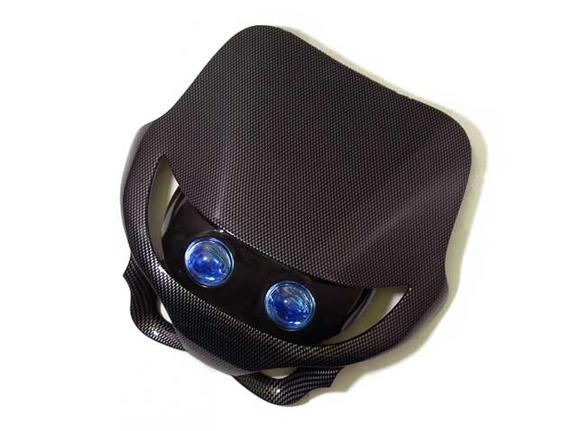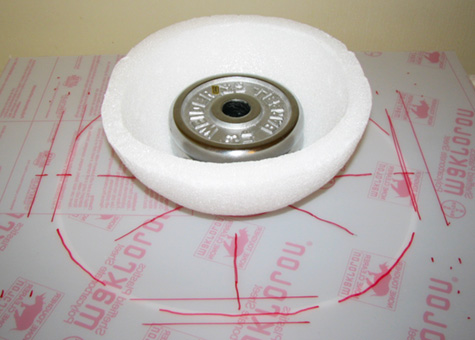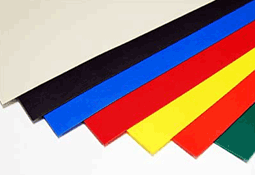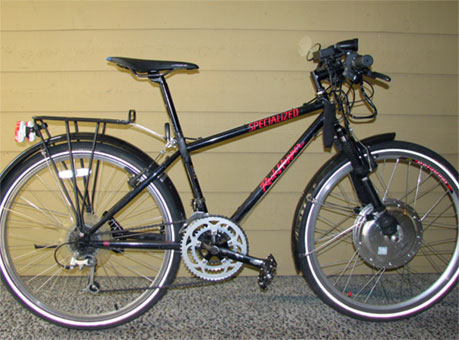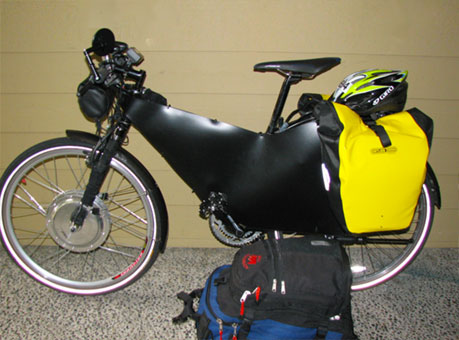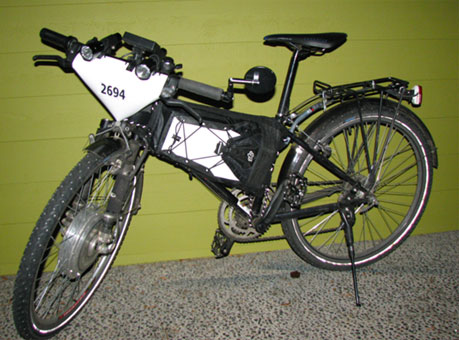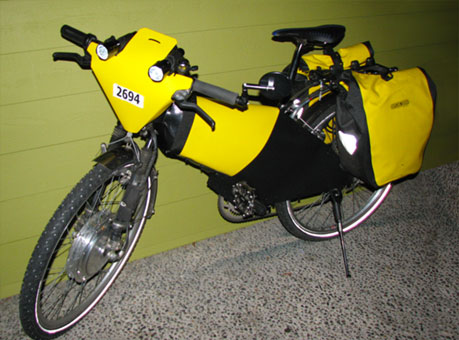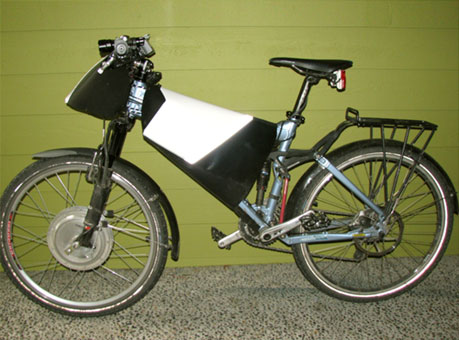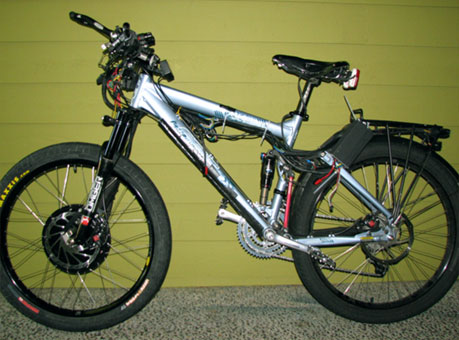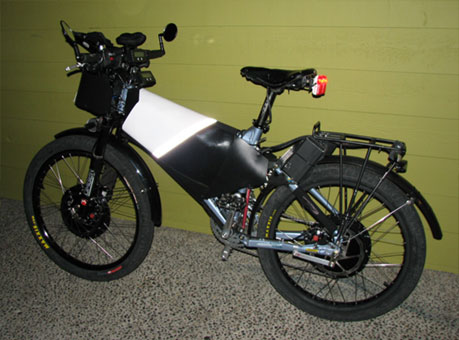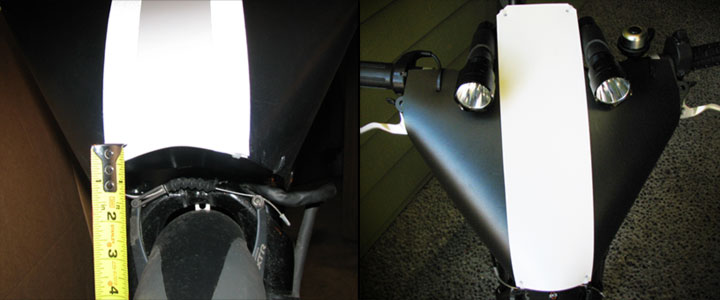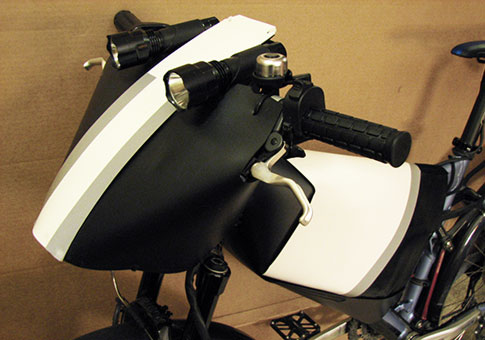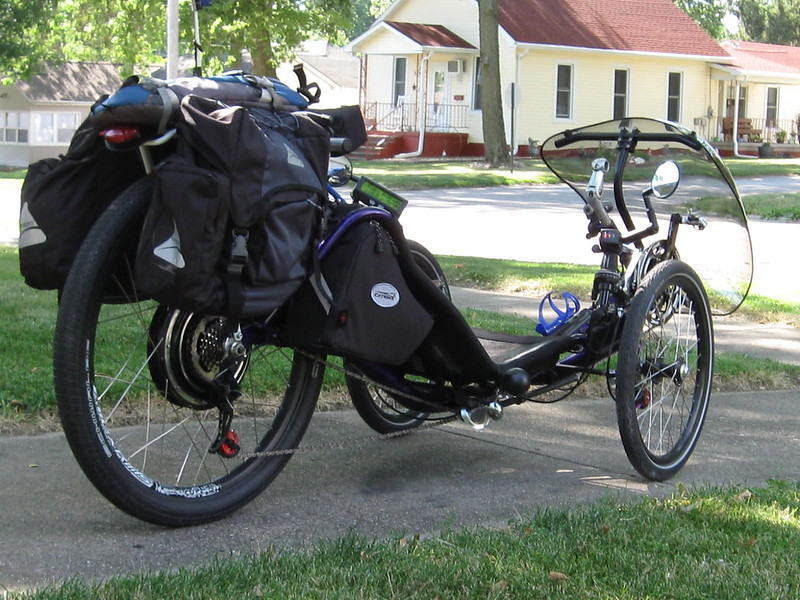DIY Fairings
Inspired by
nechaus' question

I was going to start a new thread, but this old one will work just fine, so I’ll just repurpose it to explain how I made mine.
The idea of adding a fairing to my ride was not a new one, nor was it a foreign one; probably every normal red-blooded biker out there wants a fairing if we could afford it. It had occured to me that I could have Zzipper make one for me, although it’s not terribly difficult to craft one yourself if one has a bit of time and creativity. The goal here is to break up or slice through the wind, and even if the effect is slight it will make a large difference on a long ride, possibly adding to the top speed.
My first attempt using Polycarbonate was a joke: The manager of the local plastic supplier after presenting me with an overpriced estimate said I could make my own windscreen by placing the material over a large bucket and put weight on it, then dumped boiling water. He must have been
on crack because it hardly deflected. Heat gun didn’t work out either because the material will bubble. The reality (and I knew this) is that it has to be soft focused heat – and I didn’t have a setup like that at home. Time to try something different.
This time I switched to High Density Polyethylene (HDPE) which comes in 2x4 foot sheets that are 1/32-inch thick. Very pliable and can be affected by the lightest touch of a heat gun to set the bend.
HDPE is available in limited colors from
Tap Plastics; more choices can be found if you’re willing to purchase a large order. These sheets here retail for $7.55 each.
Start with the basic bike. Here’s my 19-year old Specialized Rockhopper all
neckkid and ready to mod. Before my first road trip in 2010 I stripped the whole bike down and rewired it.
The first faring experiment was
The Black Body. I actually made this one twice cos I didn’t quite get it right the first time. The pattern was created by laying the bike down onto a large contiguous piece of cardboard, and then I traced out the shape with a pen. Butcher paper is also useful for drawing out patterns. The controller used to be right below the seat, but my leg would hit it and I had chaffing, so for the road trip, it was relocated to the front of the bike. This greatly reduced the length of phase wiring. The fairing keeps the profile of the bike nice and clean and streamlined. My top-speed instantly picked up 2-3 mph. The only disadvantage was with the force of crosswinds over bridges. There’s 18 5S1P bricks in each pannier.
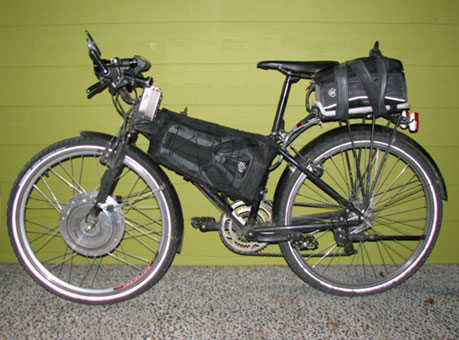
After the road trip I created a battery bag for the triangle that could hold 9 batteries per side. The trunk bag holds another 12 for a total of 30. The controller was moved again to accommodate my DC-DC converter with a heat sink. Not exactly a happy arraignment, plus the whole business was not well visible as we’re heading into Fall weather.
This was resolved by adding white HDPE side panels and crafting the first handlebar cowling. Like the original side panels, I had to make this one twice before I had it right. Permanent Red markers work best for all colors including black, and the finished product can be wiped down with isopropanol to remove the ink. By this time the weather turned frosty and I have the Schwalbe Marathon Winter Reflex mounted front and back. The problem with this configuration was that my battery bag was still getting wet, and I couldn’t have that!
This is my favorite version – and coincidentally the last for this ebike. I call it the
Yellow-Jacket look. This sported a better handlebar cowling design with a 5-piece battery bag fairing. Beautifully matches the Ortlieb panniers too. The battery bag cover included:
- Front wrap made from tough black polyvinyl material, stitched up.
- A black sheet of HDPE as a rock guard; it’s difficult to see in the image, but it runs along the bottom parallel to the downtube.
- Twin triangular rear panels made from black HDPE.
- Yellow wrapper also made from HDPE. This had Female Velcro stitched inside at each end.
The rear sides were attached first, they’re zip-tied in place. The yellow wrap goes on next, and is hole-punched so it can be laced together with tension. The rock guard is mated to the front wrap and has its own lacing that pulls it tight and is secured to the yellow wrap, leaving the rock guard hanging. After all the lacing is secured, the rock guard, with matching male Velcro stitched to it fits snugly against the yellow wrap creating a nice moisture barrier over the lacing. The yellow wrap really makes for a nice slick surface for winter weather riding.
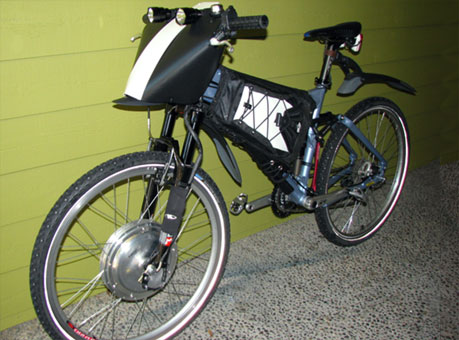
Unfortunately the Rockshox gave out on that bike. It had a 1” steerer which made sourcing a replacement problematic. I found on one eBay, but it didn’t survive the trip home from the bike shop that installed it. I had to retire my good ol’ ebike. The equipment swap occurred over New Years 2010-2011 weekend. Thus was born my present ebike made from a 2009 Felt Compulsion 1 full-suspension frame. Once again I had an opportunity to rework the wiring. The battery bag swapped over fine, but the associated covering wouldn’t fit, nor the front cowling.
Again, using construction paper I crafted up a new model which like before took me two times to get it right. The handlebar cowling made from three pieces: Black HDPE wrapped and bound to the handlebars and the front fork using zip-ties. The white stripe was added to provide additional visibility. The third piece is between the fender and the folded assembly; difficult to see – though it provides a framework that retains the shape and doubles as a moisture barrier. Most of my electronics and wiring are located directly behind the cowling, and that third piece really keeps all of that business high and dry and clean.
The battery bag wrapping was changed to conform to the new shape and incorporated additional fixes to resist rain.
- One complete wrap of heavy duty black marine polyvinyl covered the battery bag assembly, sealing it off from weather and rocks and really just plain armored it well against pointy accidents. It’s laced up at the bottom similarly to the battery bag. The front was stitched to cup-conform to the bag shape and protects against direct rain.
- Following is a wrap of white HDPE, also laced along the bottom. Along the length of the downtube parallel to both sides is a length of female Velcro on both wraps which when assembled, appears as a contiguous length.
- The front wrapper and rock guard were unified as a single piece of black HDPE, and took a few tries to get this shape correct. It ties off by wrapping from underneath and over the top, and then zipped in place. The hanging rock guard part has two lengths of male Velcro and seals right up to protect the whole undercarriage perfectly.
As a finishing tough, I added reflective tape to the trailing edge of the white wrap and handlebar cowling.
For the 2011 road trip, I stripped everything back off and rewired the entire system for 2WD. The controllers are now collocated over the rear wheel and the rest of the components are forward and hanging off the handlebar. New motors, new tires, disc brakes all around, turn signals, brake lights, dual flashers, wired for the trailer, and ready for bear.
Final version still in use today even after the road trip with the new Electra Black Plastic Balloon Townie Fender Set. One other change to the side wrapping was the inclusion of removable black side triangular panels. Behind the panels were connectors and wiring for the motors, the batteries, the trailer, and the bike computer (which I could never got to work as advertised). This I think was the best “look” for this bike, and every day of my road trip someone would always inquire where they could get one.
It’s almost perfect. :wink:
Front views of the Handlebar cowling:
- On the left, when fabricating the height, make sure to leave enough room for the front shock travel. Note the two stripes of reflective tape on the white portion. The bottom part which you can barely see just above the brake caliper provides a great barrier against wind and moisture.
- On the right, the single white HDPE length is held in place by clear/white zip-ties. The shape of the bend was augmented by using a heat gun on low setting, and it allowed the bend to relax, un-stress, and form a tighter controlled bend.
Another view of a slightly earlier version that shows the stitching along the rock guard section and reflective tape. The performance is very apparent when facing headwind; it just slices right through it! There’s plenty of room behind for electronics.
To me, this last handlebar cowling has a nice organic look to it, like the head of a bee.
Or maybe… a wasp! Perhaps harmless, or maybe not.

For other fairing uses, try perusing through
Page-5 of my trailer thread.
Also my
Epic Battery Bag Story
See you on the road,
KF

